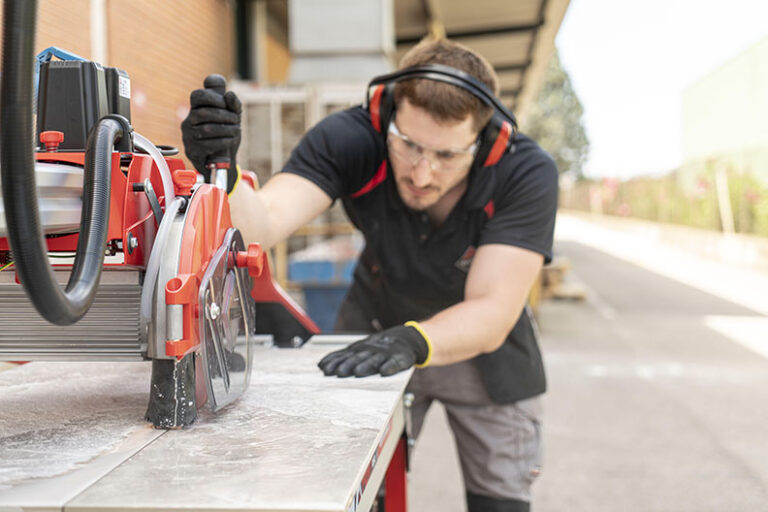In this blog post, we’ll walk you through the best practices for maintaining your wet saw — covering everything from cleaning and storage to blade care and troubleshooting.
Why Wet Saw Maintenance Matters
A wet saw may look like a rugged, indestructible machine, but it consists of multiple components that experience wear over time. Poor maintenance can result in:
- Sloppy or inaccurate cuts
- Blade damage or breakage
- Premature motor failure
- Increased dust or debris
- Safety hazards
Regular upkeep ensures your wet saw runs efficiently, extends the life of the blade and motor, and ultimately helps you achieve better results on your projects.
Daily Cleaning Routine
After each use, follow a simple cleaning regimen to prevent mineral buildup, debris clogging, and rusting.
Drain and Rinse the Water Reservoir
Begin by disconnecting the saw from its power source. Drain the water reservoir completely. Leaving standing water can cause mineral deposits and encourage mold or mildew growth.
Use a hose or bucket of clean water to flush out the pan, removing slurry and tile dust that may have settled. Scrub any caked-on residue with a soft brush.
Wipe Down Exterior Components
Use a damp cloth to wipe down the saw’s body, table, and guides. Pay special attention to the rails and sliding tray, as slurry buildup here can cause choppy movement and uneven cuts.
Avoid using harsh chemicals that could degrade plastic or painted surfaces. A mild soap solution usually does the trick.
Clean the Blade Guard and Tray
Debris tends to collect in the blade guard and cutting tray. Remove the guard, rinse it thoroughly, and scrub away any hardened dust. If your tray is removable, wash it under running water and dry it with a clean cloth.
Weekly and Monthly Maintenance Tasks
While daily cleaning is essential, deeper maintenance tasks should be scheduled weekly or monthly depending on usage intensity.
Inspect and Clean the Blade
Wet saw blades are designed for durability, but they wear down with time. Remove the blade carefully and inspect it for:
- Glazing (a shiny, smooth surface that reduces cutting efficiency)
- Warping
- Missing diamond segments
- Uneven wear
If glazing is present, you can dress the blade using a dressing stone or by cutting through an abrasive material like a concrete block. This exposes fresh diamond particles and restores cutting power.
Always make sure the blade is dry before reinstalling or storing it.
Lubricate Moving Parts
Sliding trays and guide rails need to move smoothly to ensure precise cuts. Lubricate these components using a silicone-based spray or a manufacturer-recommended lubricant.
Avoid using oil-based lubricants as they attract dust and can gum up over time.
Check the Water Pump
The pump is critical to cooling the blade and minimizing dust. Inspect the intake for blockages and clean the filter if your model includes one. Submerge the pump in clean water and power it briefly to ensure it’s working correctly.
If your saw has intermittent water flow, it may be time to replace or upgrade the pump.
Blade Maintenance Best Practices
The blade is arguably the most critical component of your wet saw, and its care goes beyond just cleaning.
Proper Blade Selection
Use the right blade for your material. Porcelain, marble, granite, and ceramic tiles all require different types of diamond blades. Using an inappropriate blade can lead to rapid wear, chipping, or dangerous kickback.
Let the Blade Do the Work
Never force the tile through the blade. Let gravity and the saw’s motor handle the cutting. Applying excessive pressure stresses the blade and motor, increasing the risk of damage.
Use a Dressing Stone Regularly
Over time, the diamond particles on your blade become embedded in the metal matrix. A dressing stone helps “unclog” the blade, removing metal buildup and exposing fresh diamonds for cutting.
Use a dressing stone every few hours of cutting time, especially when working with hard materials.
Storage Tips for Long-Term Care
Proper storage can add years to the lifespan of your wet saw.
Dry Thoroughly
Before storing, ensure every part of the saw — including the blade, tray, pump, and housing — is completely dry. Moisture invites rust and corrosion, particularly on metal parts.
Cover and Protect
Store your wet saw in a dry, enclosed area such as a garage or workshop. Use a cover or tarp to protect it from dust and environmental elements. Avoid leaving the saw outdoors, even if it’s under shelter.
Detach and Store Accessories
Remove and separately store removable parts like the water pump, trays, and fences. This reduces strain on plastic fittings and makes it easier to identify damage or wear over time.
Safety Checks and Troubleshooting
Wet saw maintenance is also about preventing accidents and ensuring safe operation.
Inspect Power Cords and Plugs
Before each use, check the power cord for frays, cuts, or exposed wires. Ensure the plug is secure and the grounding prong is intact. If you spot damage, replace the cord immediately.
Test the On/Off Switch
Confirm that the saw turns on and off without delay. A sticky or hesitant switch could indicate internal wiring issues or motor wear.
Monitor for Unusual Noises
Grinding, whining, or clunking noises are red flags. These could indicate bearing wear, loose components, or a misaligned blade. Turn the saw off and inspect it before proceeding with your work.
Common Mistakes to Avoid
Even seasoned users sometimes develop bad habits that can damage their wet saws. Avoid these pitfalls:
- Running the saw dry: Always ensure there’s water in the reservoir before making cuts.
- Using dirty water: Murky water recirculates debris that can clog the pump and dull the blade.
- Skipping clean-up: Letting slurry dry on your equipment makes cleanup harder and can corrode surfaces.
- Overloading the motor: Cutting too fast or with the wrong blade stresses the motor and reduces lifespan.
- Neglecting blade dressing: A glazed blade causes chipping and slows down your work.
When to Call in a Professional
While most maintenance tasks can be done by the user, some issues require professional servicing:
- Motor overheating or tripping breakers
- Severely warped or corroded components
- Persistent electrical issues
- Malfunctioning water pump despite cleaning
In such cases, contact the manufacturer or an authorized repair center for inspection and repairs.
Final Thoughts
Regular maintenance of your wet saw isn’t just about prolonging the machine’s life — it’s also about maintaining safety, achieving accurate cuts, and avoiding costly downtime or repairs. Whether you’re a contractor working daily or a DIY enthusiast cutting occasionally, building these habits into your routine will pay off in performance and durability.
From cleaning the water system and lubricating the rails to choosing the right blade and storing the saw properly, each step plays a crucial role in keeping your wet saw operating at peak condition.
Start implementing these best practices today, and your wet saw will continue to deliver clean, precise cuts for years to come.



































